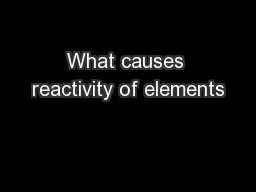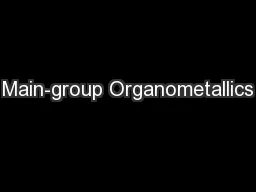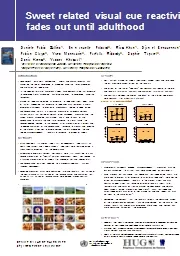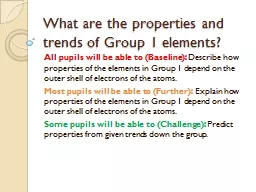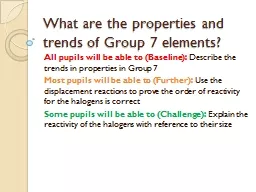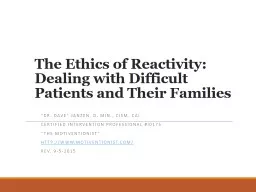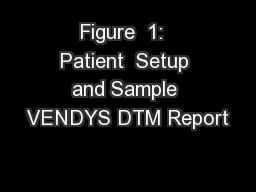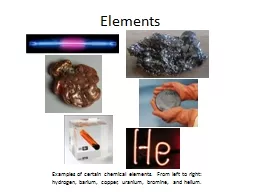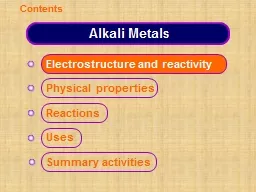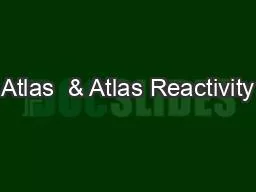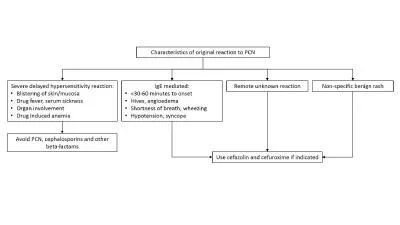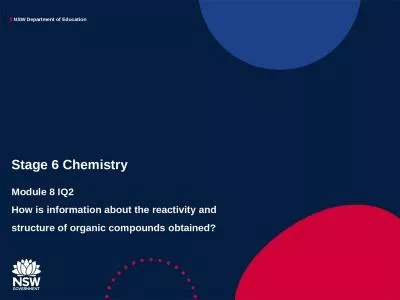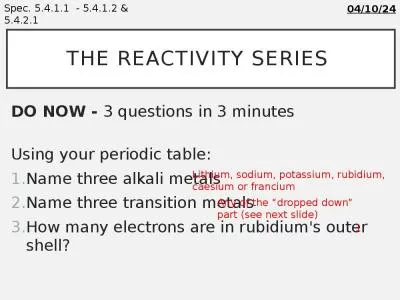PPT-What causes reactivity of elements
Author : celsa-spraggs | Published Date : 2018-12-19
All atoms want to have a completely full valence shell normally 8 electrons For the moment we will only concentrate on main group elements Noble gases are already
Presentation Embed Code
Download Presentation
Download Presentation The PPT/PDF document "What causes reactivity of elements" is the property of its rightful owner. Permission is granted to download and print the materials on this website for personal, non-commercial use only, and to display it on your personal computer provided you do not modify the materials and that you retain all copyright notices contained in the materials. By downloading content from our website, you accept the terms of this agreement.
What causes reactivity of elements: Transcript
All atoms want to have a completely full valence shell normally 8 electrons For the moment we will only concentrate on main group elements Noble gases are already full Elements that are really close desperately want to get there halogens and alkali and tend to be the most reactive. SAND No. 2012-1608C. Introduction. Chemical reactivity hazard:. A situation with the potential for an . uncontrolled chemical reaction. . that can result directly or indirectly in serious harm to people, property and/or the environment.. Peter H.M. Budzelaar. Main-Group Organometallics. 2. Main group organometallics at a glance. Structures. . s. bonds and 3. c. -2. e. (or even 4. c. -2. e. ) bonds. Synthesis. the first M-C bond. Reactivity. Daniele Fabio Zullino. 1. , Emmanuelle Fr. é. sard. 2. , Riaz Khan. 1. , Djamel Benguettat. 1. , Fabian Clays. 2. , Yves Montagrin. 2. , Farfalla Ribordy. 2. , Sophie Taparel. 2. , Sonia Krenz. All pupils will be able to (Baseline): . Describe how properties of the elements in Group 1 depend on the outer shell of electrons of the atoms.. Most pupils will be able to (Further):. . Explain how properties of the elements in Group 1 depend on the outer shell of electrons of the atoms.. 7. elements?. All pupils will be able to (Baseline):. . Describe the trends in properties in Group 7. Most pupils will be able to (Further):. . Use the displacement reactions to prove the order of reactivity for the halogens is correct. “Dr. Dave” Janzen, D. Min., CISM, CAI. Certified Intervention Professional #I0175. “The Motiventionist”. http://www.motiventionist.com. /. Rev. . 9-14-2015. Objectives. Define . Emotional . Reactivity. (Above) Illustration of patient setup, with temperature sensors affixed to both index fingers and blood pressure cuffs on both arms.. (Below left) A sample report screen displays a right finger temperature curve (red), a left finger temperature curve (blue), and a Zero Reactivity Curve (green).. What is an element?. A element is a pure substance made of one type of atom. Elements are divided into metals and non-metals. Examples of non-metal elements include carbon, oxygen, hydrogen, and nitrogen. Alkali Metals Electrostructure and reactivity Physical properties Summary activities Reactions Uses Contents H Rn Xe Kr Ar Ne Ra Ac Rf Db Sg Bh Hs Mt Ds Rg ? ? ? ? ? ? ? Ba La Hf Ta W Re Os Ir Pt Engine. . Hands. -on Session. Mobile Computing - CNT 5517-5564. Dr. . Sumi. . Helal. Professor . Computer & Information Science & Engineering Department. University of Florida, Gainesville, FL 32611. Zagursky. RJ and . Pichichero. ME. Cross-reactivity in B-Lactam Allergy. . J Allergy . Clin. . Immunol. . Pract. 2018; 6(10: 72-81. . Stage 6 Chemistry. Inquiry question - How is information about the reactivity and structure of organic compounds obtained?. This document contains topic specific content notes to support students. In addition, several self-assessment opportunities are presented for this inquiry question with HSC-style items allowing students to review their responses with regard to the marking criteria.. DO NOW - . 3 questions in 3 minutes. Using your periodic table:. Name three alkali metals. Name three transition metals . How many electrons are in rubidium's outer shell?. Spec. 5.4.1.1 - 5.4.1.2 & 5.4.2.1. Elements . of an NIH Data . Management. and . Sharing . Plan. ELEMENTS OF A DMSP. NIH NOTICE. NOT-OD-21-014. Released October 29, 2020. Elements of the Plan . Generally. Two . pages or . less. Proposed .
Download Document
Here is the link to download the presentation.
"What causes reactivity of elements"The content belongs to its owner. You may download and print it for personal use, without modification, and keep all copyright notices. By downloading, you agree to these terms.
Related Documents

